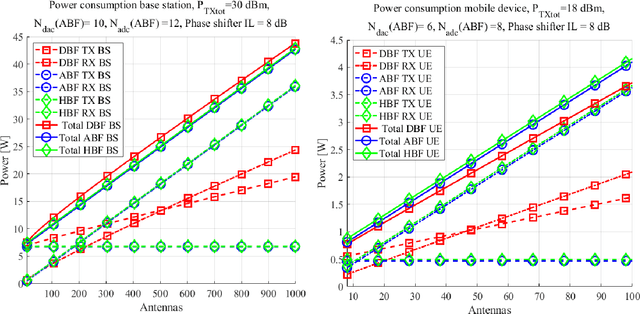Bengt Lindoff
Channel-Coherence-Adaptive Two-Stage Fully Digital Combining for mmWave MIMO Systems
Aug 06, 2025Abstract:This paper considers a millimeter-wave wideband point-to-point MIMO system with fully digital transceivers at the base station and the user equipment (UE), focusing on mobile UE scenarios. A main challenge when building a digital UE combining is the large volume of baseband samples to handle. To mitigate computational and hardware complexity, we propose a novel two-stage digital combining scheme at the UE. The first stage reduces the $N_{\text{r}}$ received signals to $N_{\text{c}}$ streams before baseband processing, leveraging channel geometry for dimension reduction and updating at the beam coherence time, which is longer than the channel coherence time of the small-scale fading. By contrast, the second-stage combining is updated per fading realization. We develop a pilot-based channel estimation framework for this hardware setup based on maximum likelihoodestimation in both uplink and downlink. Digital precoding and combining designs are proposed, and a spectral efficiency expression that incorporates imperfect channel knowledge is derived. The numerical results demonstrate that the proposed approach outperforms hybrid beamforming, showcasing the attractiveness of using two-stage fully digital transceivers in future systems.
Analysis of Quantization Noise Suppression Gains in Digital Phased Arrays
May 01, 2024Abstract:Digital phased arrays have often been disregarded for millimeter-wave communications since the analog-to-digital converters (ADCs) are power-hungry. In this paper, we provide a different perspective on this matter by demonstrating analytically and numerically how the ADC resolution can be reduced when using digital phased arrays. We perform a theoretical analysis of the quantization noise characteristics for an OFDM signal received and processed by a digital phased array, using Gaussian approximation of the OFDM signal. In particular, we quantify the quantization noise suppression factor analytically and numerically. This factor describes how much the coherent combining reduces the quantization noise as a function of the number of antennas, which allows for reducing the ADC bit resolution. For instance in a 8-16 antenna digital phased array the ADC resolution can be reduced with 1-2 bits compared to the ADC required for an analog phased array.
* \copyright 2024 IEEE. Personal use of this material is permitted. Permission from IEEE must be obtained for all other uses, in any current or future media, including reprinting/republishing this material for advertising or promotional purposes, creating new collective works, for resale or redistribution to servers or lists, or reuse of any copyrighted component of this work in other works
The Ultimate Weapon for Ultra-Broadband 6G: Digital Beamforming and Doubly Massive mmWave MIMO
Mar 03, 2021



Abstract:The use of millimeter waves for wireless communications is one of the main technological innovations of 5G systems with respect to previous generations of cellular systems. Their consideration, however, has been up to now mainly restricted to the case in which analog or, at most, hybrid analog-digital beamforming structures were used, thus posing a limitation on the multiplexing capabilities and peak data rates that could be theoretically achieved at these frequencies. Recent progress in the field of electronics, however, has made the energy consumption of digital beamforming structures at least on par with that of analog beamforming, thus redeeming them from the ghetto they had been placed in over the last year. Digital beamforming, coupled with the use of large antenna arrays at both sides of the communication link, promises thus to be one of the secret weapons of future 6G networks, capable of unleashing unprecedented values of spectral and energy efficiency for ultra-broadband connectivity.
 Add to Chrome
Add to Chrome Add to Firefox
Add to Firefox Add to Edge
Add to Edge